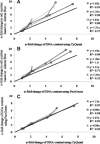Discrepancies between metabolic activity and DNA content as tool to assess cell proliferation in cancer research
- PMID: 20082656
- PMCID: PMC3823131
- DOI: 10.1111/j.1582-4934.2010.01013.x
Discrepancies between metabolic activity and DNA content as tool to assess cell proliferation in cancer research
Abstract
Cell proliferation is a critical and frequently studied feature of molecular biology in cancer research. Therefore, various assays are available using different strategies to measure cell proliferation. Metabolic assays such as AlamarBlue, water-soluble tetrazolium salt and 3-(4,5-dimethylthiazol-2-yl)-2,5-diphenyl tetrazolium bromide, which were originally developed to determine cell toxicity, are used to assess cell numbers. Additionally, proliferative activity can be determined by quantification of DNA content using fluorophores such as CyQuant and PicoGreen. Referring to data published in high ranking cancer journals, these assays were applied in 945 publications over the past 14 years to examine the proliferative behaviour of diverse cell types. In these studies, however, mainly metabolic assays were used to quantify changes in cell growth yet these assays may not accurately reflect cellular proliferation rates due to a miscorrelation of metabolic activity and cell number. Testing this hypothesis, we compared the metabolic activity of different cell types, human cancer cells and primary cells, over a time period of 4 days using AlamarBlue and the fluorometric assays CyQuant and PicoGreen to determine their DNA content. Our results show certain discrepancies in terms of over-estimation of cell proliferation with respect to the metabolic assay in comparison to DNA binding fluorophores.
Figures




Similar articles
-
Tailoring metabolic activity assays for tumour-engineered 3D models.Biomater Adv. 2025 Feb;167:214116. doi: 10.1016/j.bioadv.2024.214116. Epub 2024 Nov 12. Biomater Adv. 2025. PMID: 39561578
-
Application and evaluation of the alamarBlue assay for cell growth and survival of fibroblasts.In Vitro Cell Dev Biol Anim. 1998 Mar;34(3):239-46. doi: 10.1007/s11626-998-0130-x. In Vitro Cell Dev Biol Anim. 1998. PMID: 9557942
-
Limitations of the 3-(4,5-dimethylthiazol-2-yl)-2,5-diphenyl-2H-tetrazolium bromide (MTT) assay when compared to three commonly used cell enumeration assays.BMC Res Notes. 2015 Feb 20;8:47. doi: 10.1186/s13104-015-1000-8. BMC Res Notes. 2015. PMID: 25884200 Free PMC article.
-
Ergovaline toxicity on Caco-2 cells as assessed by MTT, alamarBlue, and DNA assays.In Vitro Cell Dev Biol Anim. 2003 Jul-Aug;39(7):329-35. doi: 10.1290/1543-706X(2003)039<0329:ETOCCA>2.0.CO;2. In Vitro Cell Dev Biol Anim. 2003. PMID: 12954076
-
An overview of colorimetric assay methods used to assess survival or proliferation of mammalian cells.Proc West Pharmacol Soc. 2011;54:10-4. Proc West Pharmacol Soc. 2011. PMID: 22423572 Review.
Cited by
-
Diseased Tendon Models Demonstrate Influence of Extracellular Matrix Alterations on Extracellular Vesicle Profile.Bioengineering (Basel). 2024 Oct 12;11(10):1019. doi: 10.3390/bioengineering11101019. Bioengineering (Basel). 2024. PMID: 39451395 Free PMC article.
-
The Effect of Calcium and Glucose Concentration on Corneal Epithelial Cell Lines Differentiation, Proliferation, and Focal Adhesion Expression.Biores Open Access. 2019 Jun 5;8(1):74-83. doi: 10.1089/biores.2018.0036. eCollection 2019. Biores Open Access. 2019. PMID: 31179162 Free PMC article.
-
Rapid Quantification of Mitogen-induced Blastogenesis in T Lymphocytes for Identifying Immunomodulatory Drugs.J Vis Exp. 2016 Dec 27;(118):55212. doi: 10.3791/55212. J Vis Exp. 2016. PMID: 28060354 Free PMC article.
-
Evaluating side effects of nanoparticle-mediated siRNA delivery to mesenchymal stem cells using next generation sequencing and enrichment analysis.Bioeng Transl Med. 2016 Jun;1(2):193-206. doi: 10.1002/btm2.10035. Epub 2016 Oct 24. Bioeng Transl Med. 2016. PMID: 27981244 Free PMC article.
-
The impact of wavelengths of LED light-therapy on endothelial cells.Sci Rep. 2017 Sep 6;7(1):10700. doi: 10.1038/s41598-017-11061-y. Sci Rep. 2017. PMID: 28878330 Free PMC article.
References
-
- Jones LJ, Gray M, Yue ST, et al. Sensitive determination of cell number using the CyQUANT cell proliferation assay. J Immunol Methods. 2001;254:85–98. - PubMed
-
- Pierre RV. Peripheral blood film review. The demise of the eyecount leukocyte differential. Clin Lab Med. 2002;22:279–97. - PubMed
-
- Mosmann T. Rapid colorimetric assay for cellular growth and survival: application to proliferation and cytotoxicity assays. J Immunol Methods. 1983;65:55–63. - PubMed
-
- Berridge MV, Herst PM, Tan AS, et al. Biotechnology Annual Review. Elsevier: 2005. Tetrazolium dyes as tools in cell biology: new insights into their cellular reduction; pp. 127–52. - PubMed
-
- O’Brien J, Wilson I, Orton T, et al. Investigation of the Alamar Blue (resazurin) fluorescent dye for the assessment of mammalian cell cytotoxicity. Eur J Biochem. 2000;267:5421–6. - PubMed
Publication types
MeSH terms
Substances
LinkOut - more resources
Full Text Sources
Other Literature Sources
Miscellaneous

